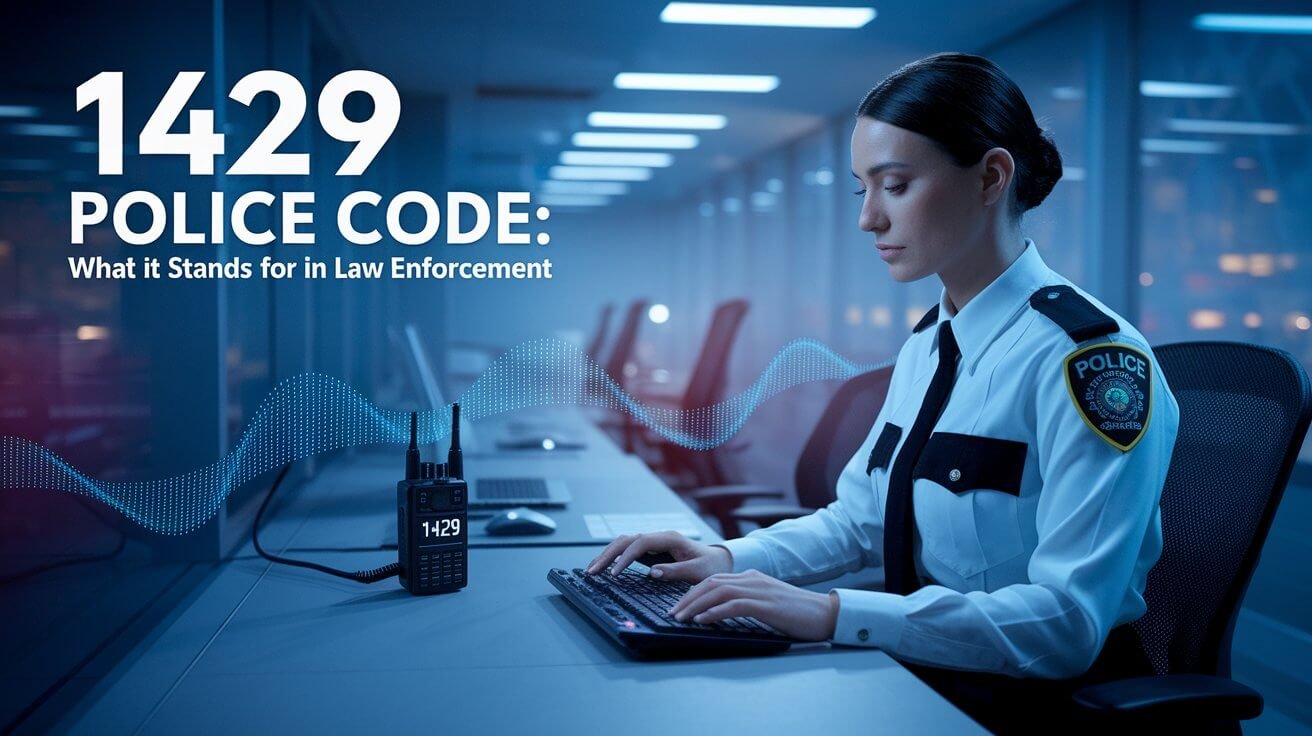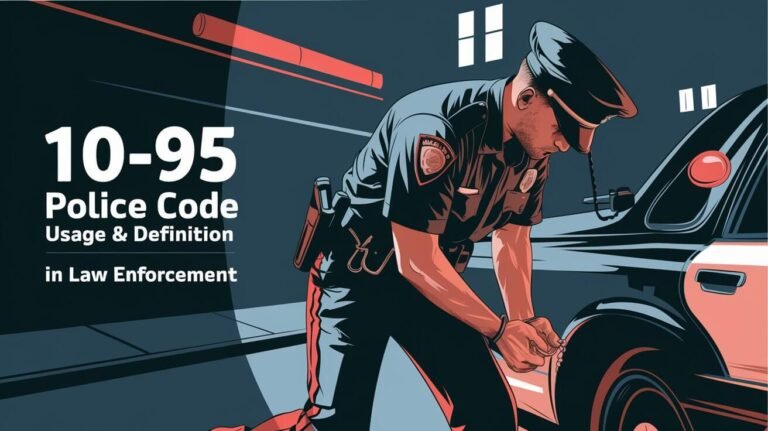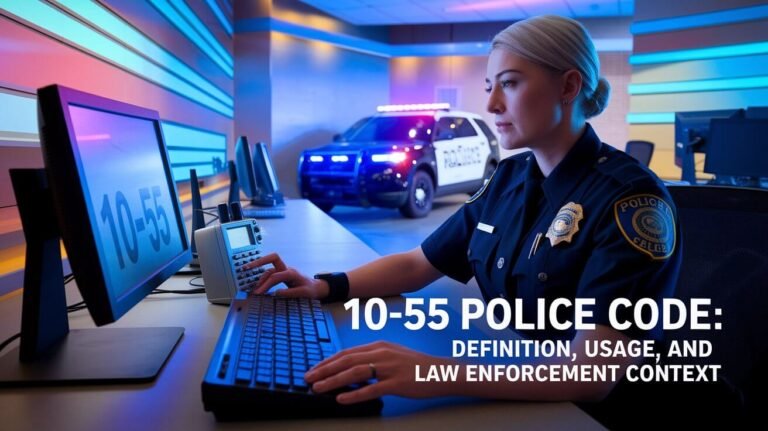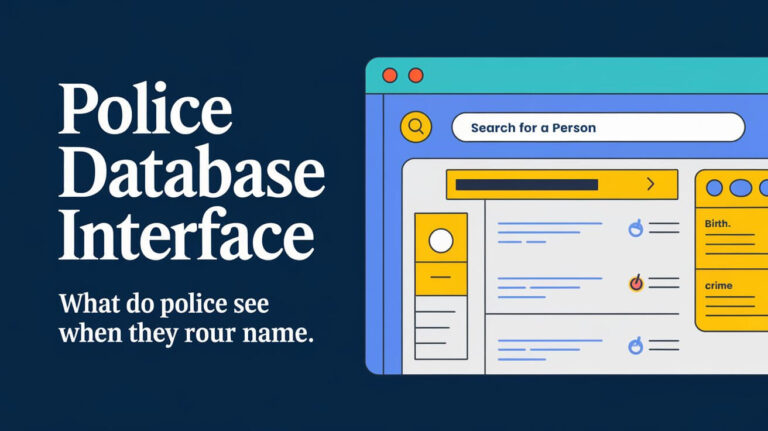1429 Police Code: What It Stands for in Law Enforcement

Law enforcement agencies use a variety of emergency codes to communicate effectively during critical situations. One such code is the 1429 Police Code, which plays a crucial role in maintaining public safety.
This specific police code is part of a broader system of codes used by law enforcement to convey information quickly and efficiently. The use of these codes helps in coordinating responses to emergencies and crimes.
By exploring the meaning and significance of the 1429 Police Code, we can gain a deeper understanding of law enforcement’s communication strategies and their impact on public safety.
Key Takeaways
- Law enforcement agencies utilize various emergency codes for effective communication.
- The 1429 Police Code is a specific code used in critical situations.
- Police codes are essential for maintaining public safety.
- These codes enable law enforcement to respond efficiently to emergencies.
- Understanding police codes can provide insights into law enforcement strategies.
What the 1429 Police Code Means
Understanding the 1429 Police Code is crucial for grasping its significance in law enforcement communications. This code is part of a specialized language that enables law enforcement officers to convey complex information quickly and efficiently.
Official Definition in Police Terminology
The 1429 Police Code is defined within police terminology as a specific signal or request for action. According to law enforcement sources, ten-codes like 1429 are designed to facilitate clear and concise communication among officers. The official definition is critical for ensuring that officers respond appropriately to the code.
- It signifies a particular situation or condition.
- It requires immediate attention or action from law enforcement personnel.
Immediate Actions Required Upon Code Transmission
Upon transmission of the 1429 Police Code, law enforcement officers are expected to take immediate and specific actions. These actions are guided by departmental protocols and training. The code transmission triggers a series of responses, including:
- Confirmation of receipt of the code.
- Assessment of the situation.
- Appropriate response based on the code’s meaning and departmental procedures.
History and Origin of Numerical Police Codes
The history of numerical police codes is deeply rooted in the need for efficient communication among law enforcement agencies. These codes were developed to simplify radio communications, making it easier for officers to quickly understand the nature of a call or situation.
Birth of the Ten-Code System
The ten-code system was developed in the early days of radio communication to provide a standardized method of conveying common messages between law enforcement officers and dispatchers. This system allowed for quicker and more efficient communication, reducing the risk of misunderstandings.
Key features of the ten-code system include:
- Standardized codes for common situations
- Improved clarity in radio communications
- Reduced transmission time
| Code | Description | Usage |
|---|---|---|
| 10-4 | Acknowledgment or confirmation | Commonly used to confirm receipt of a message |
| 10-20 | Location or position | Used to request or provide location information |
| 14-29 | Specific code designation | Used for specific situations or alerts |
First Implementation of the 1429 Designation
The 1429 Police Code has its roots in the broader ten-code system, with its specific designation and meaning evolving over time to address particular needs within law enforcement. The first implementation of the 1429 designation marked an important milestone in the evolution of police codes, providing a unique identifier for a specific situation or alert.
Use of the 1429 code has been adapted and modified by various law enforcement agencies to suit their operational needs, highlighting the flexibility and utility of the numerical code system.
The 1429 Police Code in Different Jurisdictions
The interpretation of the 1429 police code varies significantly across jurisdictions. This variation is a result of different law enforcement needs and historical developments in various regions.
City-by-City Variations
The usage of the 1429 police code differs between major metropolitan areas and rural departments. In metropolitan areas, the code is often used in complex, high-stakes operations.
Major Metropolitan Interpretations
Major cities like New York and Los Angeles have their own protocols for using the 1429 code, often tied to specific emergency response situations.
Rural Department Adaptations
Rural departments, on the other hand, may use the code less frequently due to the lower frequency of the incidents it signifies.
Federal Agency Usage
Federal agencies play a crucial role in standardizing the use of the 1429 police code. They provide guidelines that help maintain consistency across different jurisdictions.
| Jurisdiction | Usage Frequency | Primary Use Cases |
|---|---|---|
| Major Metropolitan Areas | High | Complex emergency responses |
| Rural Departments | Low | Specific, rare incidents |
| Federal Agencies | Moderate | Standardization and training |
Practical Field Applications of 1429 Code
Understanding the 1429 Police Code is essential for both patrol officers and dispatch centers to respond effectively to emergencies and incidents.
Patrol Officer Responses
When a 1429 code is transmitted, patrol officers are required to respond promptly, following established protocols that may include assessing the situation, providing assistance, and securing the scene.
The code is often used in situations that require immediate attention, and officers must be prepared to adapt their response based on the specific circumstances they encounter.
- Assess the situation upon arrival
- Provide necessary assistance
- Secure the scene to prevent further incidents
Dispatch Center Protocols
Dispatch centers play a critical role in managing the response to a 1429 code by implementing specific protocols.
Priority Classification
Upon receiving a 1429 code transmission, dispatchers must classify the incident based on its priority, determining the level of response required.
This involves assessing the severity of the situation and allocating resources accordingly.
Resource Allocation
Effective resource allocation is crucial in responding to incidents coded as 1429.
Dispatchers must allocate the appropriate resources, such as patrol units, emergency services, or specialized teams, to ensure a timely and effective response.
- Identify the resources needed based on the incident’s nature
- Dispatch the necessary units promptly
- Monitor the response and adjust as necessary
Radio Communication and the 1429 Police Code
Clear and precise radio communication is vital for law enforcement operations, with codes such as 1429 being integral to this process. Effective radio communication ensures that information is conveyed quickly and accurately, which is critical in high-pressure situations.
Transmission Clarity Requirements
Transmission clarity is paramount when communicating the 1429 Police Code. Clear enunciation and standardized terminology help prevent misunderstandings. Law enforcement agencies often implement specific protocols to ensure that transmissions are clear and concise.
- Use of plain language
- Avoidance of jargon unless necessary
- Standardized code usage
Confirmation Procedures
Confirmation procedures are equally important to ensure that the 1429 Police Code is understood correctly. These procedures involve repeat-back protocols and documentation standards.
Repeat-Back Protocols
Repeat-back protocols require the receiving party to repeat back the information received to confirm accuracy. This step is crucial in preventing miscommunications.
- The dispatcher transmits the 1429 code.
- The officer receiving the code repeats it back.
- The dispatcher confirms the repeat-back.
Documentation Standards
Documentation standards ensure that all communications, including those involving the 1429 Police Code, are recorded and stored properly. This is vital for future reference and legal purposes.
| Documentation Aspect | Description |
|---|---|
| Date and Time | Record of when the transmission was made |
| Code Details | Specifics of the 1429 code transmission |
| Responding Unit | Identification of the unit that responded to the code |
Legal Aspects and Public Safety Implications
The use of the 1429 Police Code raises important questions about its admissibility in court and its implications for community trust. As law enforcement agencies continue to rely on coded communications, understanding the legal and public safety implications becomes increasingly important.
Court Admissibility of Code-Based Communications
The admissibility of communications using the 1429 Police Code in court proceedings is a complex issue. Courts have to consider whether such coded messages constitute hearsay or if they fall under exceptions due to being part of official duty. Key factors influencing admissibility include the context of the communication and the relevance to the case at hand. For instance:
- The clarity and specificity of the code used
- The training and familiarity of officers with the code
- The potential for misinterpretation by the court or jury
Community Impact Considerations
The impact of the 1429 Police Code on community trust and public safety is multifaceted. On one hand, efficient coded communication can enhance response times and operational effectiveness. On the other, the use of codes can create a barrier between law enforcement and the public if not properly understood or communicated. Effective community policing strategies must balance the need for efficient communication with transparency and public understanding.
Common Misconceptions About Police Codes
There’s a significant gap between the Hollywood version of police codes and their real-life application. The public’s understanding of these codes is often skewed by media portrayals, leading to misconceptions about their actual use and significance.
Hollywood vs. Actual Police Practice
Movies and TV shows frequently dramatize police codes, using them to create suspense or convey complex plot points. However, this dramatization often misrepresents the codes’ true purpose and functionality. In reality, police codes like the 1429 Code are used for efficient and clear communication among law enforcement officers. Understanding the difference between Hollywood’s portrayal and actual police practice is crucial for a realistic view of law enforcement operations.
Civilian Interpretation Errors
Civilians may misinterpret police codes due to a lack of exposure to their actual use or through misinformation from media sources. This misinterpretation can lead to confusion and, in some cases, may hinder effective communication between law enforcement and the public. Educating the public about the true nature and purpose of police codes can enhance cooperation and understanding between civilians and law enforcement agencies.
Related Emergency Codes and Their Relationships
Emergency responders rely on a variety of codes, including the 1429 Police Code, to communicate effectively during critical situations. These codes are part of a broader system designed to convey complex information quickly and efficiently.
Associated Numerical Designations
The 1429 Police Code is one of many numerical designations used by law enforcement and emergency services. Other associated codes include:
- Code 4: Indicates that a situation is under control and no further assistance is required.
- Code 5: Signifies a stakeout or surveillance operation.
- Code 3: Typically means emergency response with lights and sirens.
Understanding these codes and their meanings is crucial for effective communication among emergency responders. Each code has a specific purpose and is used in different contexts to convey vital information quickly.
Cross-Agency Code Compatibility
Cross-agency compatibility is essential for ensuring that different emergency response agencies can work together seamlessly. This compatibility involves:
- Standardizing codes and their meanings across jurisdictions.
- Implementing interoperable communication systems.
- Conducting regular training exercises to ensure familiarity with codes used by different agencies.
Achieving cross-agency code compatibility, emergency responders can coordinate their efforts more effectively, leading to more efficient and effective emergency responses.
Modern Technology and Code Evolution
Integration of modern technology is revolutionizing police communication codes. As law enforcement agencies adopt digital communication systems, the traditional use of numerical codes like the 1429 Police Code is evolving.
Digital Communication Systems
Digital communication systems offer enhanced clarity and efficiency in police communications. These systems allow for the rapid transmission of detailed information, reducing the reliance on numerical codes.
Plain Language Movement Impact
The plain language movement is another factor influencing the evolution of police codes. This movement advocates for the use of clear, straightforward language in emergency communications, potentially reducing the need for specialized codes.
NIMS Compliance Issues
The National Incident Management System (NIMS) requires law enforcement agencies to adopt standardized communication practices. Compliance with NIMS can be challenging as agencies transition to new systems.
Transition Challenges
Transitioning to modern communication systems poses several challenges, including training personnel and ensuring compatibility with existing infrastructure. A comparison of the challenges and benefits is illustrated below:
| Challenge | Description | Benefit |
|---|---|---|
| Training Personnel | Requires significant training for effective use | Enhanced operational efficiency |
| Infrastructure Compatibility | May require upgrades to existing systems | Improved communication clarity |
| Cost Implications | Initial investment in new technology | Long-term cost savings through efficiency |
As law enforcement continues to embrace modern technology, the use of police codes will likely continue to evolve. Understanding these changes is crucial for effective communication in emergency situations.
Conclusion
The 1429 Police Code plays a vital role in law enforcement communication, with significant implications for public safety and effective operations. Understanding its meaning, history, and practical applications is essential for appreciating its role in maintaining law and order.
In summary, the 1429 Police Code is a crucial component of police terminology, used to convey specific information quickly and efficiently. Its significance extends beyond law enforcement agencies, as it contributes to the overall safety and well-being of the community.
The police code significance is evident in its ability to facilitate clear and concise communication among law enforcement personnel, allowing them to respond effectively to emergency situations. As law enforcement communication continues to evolve, the importance of codes like 1429 remains unchanged, serving as a foundation for efficient and effective policing.
The 1429 Police Code is an essential tool in law enforcement, and its continued use is vital for maintaining public safety and trust.
Popular Post Queries
What does the 1429 Police Code signify?
The 1429 Police Code is a specific signal used by law enforcement agencies to convey a particular situation or request for action, requiring officers to respond accordingly.
How is the 1429 Police Code used in different jurisdictions?
The interpretation and usage of the 1429 Police Code can vary significantly across different jurisdictions, with major metropolitan areas and rural departments having different adaptations.
What is the history behind numerical police codes like the 1429 Police Code?
History of numerical police codes, including the ten-code system, dates back to the early days of law enforcement communication, with the 1429 Police Code being part of this system.
How do law enforcement agencies respond to the 1429 Police Code?
Patrol officers respond to the 1429 Police Code based on established protocols, while dispatch centers play a critical role in prioritizing and allocating resources upon receiving the code transmission.
What are the implications of the 1429 Police Code in court proceedings?
The 1429 Police Code has significant legal implications, particularly regarding its admissibility in court proceedings, and understanding its community impact is essential for maintaining public safety and trust in law enforcement agencies.
How is the 1429 Police Code used in radio communication?
The 1429 Police Code is an integral part of law enforcement radio communication, requiring transmission clarity and following confirmation procedures, such as repeat-back protocols, to ensure accurate communication.
What is the impact of digital communication systems on the 1429 Police Code?
Advent of digital communication systems is transforming the way law enforcement agencies use police codes, including the 1429 Police Code, with implications for NIMS compliance and transition challenges.
How does the plain language movement affect the usage of the 1429 Police Code?
The plain language movement is having a significant impact on code usage, including the 1429 Police Code, with implications for law enforcement communication and coordination during emergency responses.
What are some common misconceptions about police codes like the 1429 Police Code?
Police codes, including the 1429 Code, are often misrepresented in media and popular culture, with differences between Hollywood portrayals and actual police practice that can lead to civilian interpretation errors.
How does the 1429 Police Code relate to other emergency codes?
The 1429 Police Code is part of a broader system of emergency codes used by law enforcement and other agencies, requiring understanding of associated numerical designations and cross-agency code compatibility.






